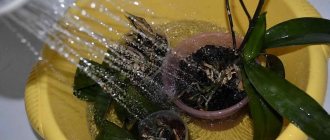After purchasing an orchid, the new owners face a difficult but feasible task - to do everything so that the orchid blooms as long as possible and as often as possible . The orchid is a rather whimsical plant, caring for which is a real science.
Many gardeners cannot provide plants with favorable living conditions. If you follow all the simple rules, you can extend the flowering of an orchid from two to six months. And some species, with proper care, can bloom all year round.
Improper care of the plant leads not only to the cessation of flowering, but also to the death of the orchid. Next, we will tell you how this capricious plant blooms, describe the signs and photos of this process.
Peculiarities
Experts note the following features of the flowering of this plant:
- the orchid blooms for the first time after reaching the age of two;
- if the plant was received from a child, you will need to wait until 6 airy petals form;
- the orchid needs adaptation and a calm state, i.e. There is no point in moving the pot from place to place.
Sometimes the conditions for keeping an orchid are so good that the flower puts all its energy into developing its leaves and root system. In this case, experienced gardeners recommend “scaring” the orchid - moving the pot to a cooler place or reducing watering to a minimum. Such a shock stimulates the plant to flower.
When do they bloom and how often?
Each type and variety of orchids has its own favorite period for flowering, and it is not always summer; flowers can bloom all year round. The extent to which these habits persist in the conditions of our apartments can only be judged from our own experience.
"Phalaenopsis", the most common orchid on our windowsills, can bloom from January to December. "Miltonia", also called "Butterfly Wings", usually blooms in spring or autumn, but may well bloom in summer or winter, although this is rare. Her hybrid "Miltassia" blooms from March to July, re-blooming can be expected from late summer until February. The “Cymbidium” orchid is usually recommended to be given as a gift to people who have no experience in growing exotics; it is unpretentious and not capricious, it usually blooms from October to February, but can please with additional blooms in spring and summer.
The tall Dendrobium orchid blooms from October to January, and may additionally bloom flowers in the summer. The very popular 'Oncidium' species usually blooms from April to mid-summer, but may go into another bloom from late autumn. “Paphiopedilum” is increasingly increasing its popularity among flower growers; it can be seen blooming from mid-autumn to spring, then an obligatory dormant period begins.
“Odontoglossum” is one of those species that is difficult to grow at home, it is difficult to care for, it is bought by experienced gardeners who have been growing orchids for many years. Its main flowering time is from February to May, it can repeat flowering in early autumn, but can bloom in summer or very late autumn. The Zygopetalum orchid is very demanding when it comes to watering; if everything is done correctly, then from November to February it will definitely delight you with flowering.
The charming Cattleya usually blooms from April to November, but can bloom in winter or early spring; it responds well to good care and delights with flowering.
Photo
In the photo below you can see what an orchid looks like in bloom:
Necessary Requirements
Even taking into account the above features, the orchid must provide the necessary conditions for the flowering process. What is needed?
- The orchid pot must be transparent so that the root system receives enough light for photosynthesis.
- The home flower is in dire need of sunlight. If there is a lack of it, the plant simply stops growing and developing. And if in the summer there is enough sun, then in the fall and winter it is necessary to organize additional lighting.
- For the formation of buds, the temperature regime must be observed. During the day it is from 20 to 24 degrees, at night - 15-18.
- For abundant and regular flowering, the soil is fertilized with preparations containing phosphorus and potassium. But it is important not to overdo it with nitrogen - from its excess, flowering will stop and only leaves will develop.
- Excess moisture will have a bad effect on the formation of new flower stalks, so watering should be moderate. In this case, it is carried out after the soil has completely dried.
- Too dry air leads to the death of the peduncle. Optimal indicators are 60% and above.
Orchid - superstitions and signs associated with the plant
An orchid is a truly beautiful flower. With its appearance it creates a feeling of spiritual saturation and hormonal satisfaction. Its delicate flower really surprises with its combination of splendor and lightness, and the smell makes you forget everything that is happening around you. You literally get drunk and are hypnotized. It seems that the orchid has combined the most beautiful qualities of flowers and enhanced them several times.
It would seem that such a flower cannot have a single flaw, but signs and superstitions completely disagree with this. To know exactly the meaning of an orchid, we have written this material for you! We hope it will be useful for everyone. Ready to learn the signs about the orchid? Then let's begin!
Periods
The entire flowering process is divided into several periods:
- Vegetation. The period begins at the moment of formation of a new shoot. Not only the leaves grow, but the root system also actively develops.
- Peace. Peduncle growth and new bud buds.
- Bloom. Formation of buds and their opening. This period takes a lot of energy from the plant.
- Rest.
- Active vegetation. With proper care, this phase ends with repeated flowering.
What are the signs associated with the orchid based on?
The orchid has a unique energy. Of course, such power cannot be subject to everything. Therefore, at some points it creates negative energy, which is very difficult to destroy. This is explained by the balance of positive and negative forces in nature. You will have to come to terms with this and use it only according to the rules outlined in this material.
The orchid is a very feminine flower. Therefore, it creates only feminine energy. This is not bad, but only in certain cases. It is important to learn how to use this force correctly, because otherwise you will upset the balance that we talked about above. Be careful! It's time to talk about the signs associated with the orchid.
How long does it last?
There is no general answer to this question, because the flowering period depends on the crop variety and the conditions under which it is kept. For example: dendrobium pleases with flowers for 3-4 months, and cattleya blooms for only two. On average, each flower stays on the stem for about 3-4 weeks.
The longest flowering is observed in the phalaenopsis variety. It lasts about six months. Moreover, this variety is less demanding to care for and is therefore recommended for beginners in orchid breeding.
Under ideal conditions, the orchid is capable of flowering 2-3 times a year. The dormant period between each color takes several months. The above-mentioned phalaenopsis, with sufficient fertilizers, practically does not experience such a need.
A home orchid can bloom at any time of the year. Interestingly, the color lasts the longest in winter.
Is it possible to keep the plant at home?
The plant is allowed to be grown at home, but with some reservations.
An orchid, delighting with its beauty, is able to absorb positive energy. This is most likely true, because it is a representative of epiphytes that can grow without soil, even on tree trunks, like parasites. It is believed that they can “vampire” with a person - that’s why, according to popular beliefs, you can’t keep orchids at home.
In addition, the biofield becomes weaker when a person sleeps, and after waking up, a feeling of fatigue will be felt next to the flower. Therefore, you cannot place an orchid in the bedroom.
Several types of orchids produce pollen on their petals, which acts like a sleeping pill on people, making them feel worse.
A man should not come into contact with an orchid very often. Let her be where he does not go, because otherwise she will become pampered and display many feminine qualities.
Is it possible to artificially stimulate the process?
It is not recommended to artificially stimulate a young plant, as this can lead to the death of the orchid. However, if the flower is healthy, there are several simple ways to help the plant bloom:
- Organize a temperature change. At night the plant is placed in a cool place, and in the morning it returns to its native windowsill. If necessary, the procedure is repeated 2-3 times.
- Reduce watering for a short period, and then return to normal.
- Use compositions that stimulate flowering - “Ovary”, “Bud”, “Plumen”.
Sometimes a hot shower is used. The plant is rinsed under running hot water (40-45 degrees). Carry out 2-3 approaches of 10 seconds. Between approaches, take a break of 15-20 minutes. This procedure invigorates the orchid - in conditions of danger, it strives to leave offspring and throws out flower stalks. However, this technique is considered dangerous and is used in exceptional cases.
What does Feng Shui say?
Some sources of Feng Shui teachings have a negative attitude towards keeping the plant at home, while others say that it can be grown by following certain rules :
- they don’t keep a flower in the bedroom;
- in case of illness or to maintain health, the orchid is placed in the east;
- whoever achieves success in his career should place a flower in the north;
- dreams will come true if the pot is in the southeast;
- A plant located in the northwest will help you find peace and tranquility.
Nuances of plant care before, during and after flowering
It is no secret that the orchid is a capricious plant and requires compliance with all the rules of care:
- Care before flowering. During the dormant period, before the buds open, it is necessary to regularly water, maintain temperature conditions, apply fertilizers and monitor the amount of light and humidity levels.
If an orchid was transplanted, then immediately after that it is watered with boiled water with the addition of magnesium or potassium to replenish it. It is best to immerse the container with the orchid in the prepared solution and let it sit for half an hour. In the future, watering is carried out immediately after the soil dries. - During flowering. After the buds open, the orchid is well moistened by irrigating the aerial roots with warm water (slightly above room temperature).
If there is not enough moisture, the peduncle will dry out and die. The room where the blooming orchid stands is regularly ventilated (avoiding drafts), and the air is humidified. You can use special equipment or place a bowl of water next to the orchid. As soon as the buds open completely, watering is reduced. - After flowering. Old flower stalks are cut off to allow new ones to appear. However, the arrows must dry well, otherwise the risk of the orchid getting sick increases. It takes a little time for the plant to recover and bloom again. Therefore, immediately after flowering, fertilizers are applied so that the plant gets stronger and gains strength to bloom again.
Orchid is a strong female talisman! Signs about an orchid in the house!
Thanks a lot! That’s it, now I’ll definitely move my orchids to another room!
I remember how my husband gave me my first orchid. Yes, I agree that this mysterious flower is a talisman for women. Then I had a difficult period in my life, but with the appearance of an orchid in my kitchen, everything got better. I haven’t connected these two events before, but there is a connection!
It is difficult to find among the plant world another flower as mysterious as the orchid. There are conflicting signs and superstitions about this whimsical indoor plant, forcing housewives to think several times before placing it in the house.
For many people, signs and superstitions are very important. There is a lot of debate among flower lovers about whether orchids can be grown at home. The orchid is an ancient and very beautiful flower.
She is considered a symbol of chastity, sinlessness, impeccability, grace, charm and unity. There are a huge number of prejudices about orchids, but many of them are based on life experience, and therefore they should be trusted.
Negative signs and superstitions
Orchids are considered “energy vampires”. Many believe that the orchid takes all the energy, reduces the performance and activity of those who live in the same house with it.
It is also believed that the orchid devours male energy, driving the stronger sex out of the house. But it is not so. The orchid is truly a female flower. It gives girls more femininity and beauty. Such a flower really has a negative effect on the male sex: the orchid makes a man too soft and gentle.
Negative signs about orchids are scary, but this does not mean that the flower cannot be grown at home. As a vampire, the orchid is active only at night, so if possible it is better not to place them in the room where you sleep. In addition, protect men from contact with this flower.
Positive signs and superstitions
The orchid is a completely safe flower - it’s just too whimsical and capricious. If you love it and care for it, observe certain conditions, then this indoor plant will give you well-being, happiness and harmonize the microclimate in the family.
An orchid can serve as a talisman for a woman. By contacting such a flower, you can discover hidden talents, great potential and begin to practice art. But for this you should take good care of the flower and care for it properly. Under no circumstances should the orchid be allowed to become sick or wilt.
An orchid, among other things, can extend life. A woman can get rid of wrinkles, improve her health and beauty. Orchids also lift your spirits. With the help of this flower you can get rid of negative energy in the house. At the same time, orchids of different colors have a certain character.
This beautiful flower can serve as a protector in the home. If you are visiting a person who does not wish you well, the orchid will do everything to make the enemy leave your home. It makes your enemies feel physically ill. These include headaches, poor mental health and fever.
Other signs and superstitions about the orchid
Plant scientists believe that the orchid affects each person differently. It depends on the care of the plant and its color. For example, scarlet and purple orchids help combat laziness. Flowers of this color are perfect for females who are on a diet. They also help you quit smoking and start exercising.
Yellow orchids will help you increase your material wealth and achieve success in your career. This also applies to orange flowers. They promote an active lifestyle. Flowers of this color are perfect for creative people, awakening their inspiration.
White and pink flowers help to achieve inner harmony. Plants in these colors are suitable for depressed people. Pink flowers will help you feel attractive and charming.
Overall, the orchid is a wonderful flower to grow at home. It will suit any girl, will help her feel beautiful and awaken her femininity. The orchid will protect from negative energy, ill-wishers and evil. Just try to care for it properly, and then you will be able to see all the wonderful sides of this truly mysterious flower.
Orchid patronizes women, helps them achieve their goals, discover talents, prolong youth, preserve beauty...
If there are no buds
Gardeners often complain that their plant does not bloom (for example, buds do not form or bloom). There are a number of common reasons that can affect the onset of flowering in an exotic beauty.
- The rest regime with alternating watering and temperature conditions is not observed (for example, at night the air temperature does not decrease or the decrease is insignificant). In this case, it is necessary to remove the plant at night to a cooler place or ventilate the room.
- A new bud does not form if the efficiency of photosynthesis is reduced and the plant lacks energy. Make sure to maintain daily temperature changes and maintain daylight hours of at least 12 hours.
- Abundant watering. The flowering period of the orchid is a time of dry conditions.
- Incorrect selection of fertilizer. Excess nitrogen interferes with the development of the peduncle, stimulating leaf growth. Apply fertilizers containing potassium and magnesium to the soil at this time.
- Lack of light for roots. Provide a fairly transparent container for the orchid so that the root system has good access to light.
Signs about the orchid
Orchid - energy vampire
Many teachings confirm that the orchid has the ability to suck the life energy from the owner. Even Feng Shui, which encourages vegetation in the house, notes this negative effect. The fact is that the pollen of some types of orchids tends to cause drowsiness. It turns out that a large accumulation of these flowers creates an atmosphere where all the energy goes only to them.
Therefore, it is not recommended to keep the orchid indoors. It is best to plant it outside, where it will feed on the energy of the world, not yours.
Orchid - muzhegon
Muzhegon is a thing that destroys male energy and enhances female energy. Orchid belongs to this number. Her energy completely burns out the masculine principle. Due to this factor, several rules have appeared to correct this property:
- An orchid can and should be placed in a room where only girls live. This will create an unusual aura around them that will attract guys. An orchid will emphasize feminine attractiveness, leaving no chance for even the most reserved men. This is a huge advantage of the orchid’s properties. In some countries, this flower is planted in the room of girls who will soon be getting married.
- Under no circumstances should an orchid be placed in a men's room. So its owner will lose strength of character, he will be dependent on the woman. Even his male charm will leave him. Keep this rule in mind when arranging flowers in your home.
- It’s also better not to place an orchid in the spouses’ room. The husband will chase his wife's skirt, and hardly anyone will like this. In such rooms it is better to place neutral flowers.
These are the rules! Follow them, and everything in your life will be fine!
Orchid conveying positive properties
The orchid, as we have already noticed, is a very light and airy flower. She can transfer these same qualities to the owner (not the owner!). To do this, it is enough to place this flower in the place where the hostess visits most often. You can even bring it to work. What does this flower give?
- Health. Yes, he transmits healthy energy to the hostess. This is very useful, because health is our everything!
- Good luck. If well cared for, she can share the good fortune in life. Therefore, the work option comes in handy!
- Attractiveness to men. Yes, yes, if you encounter an orchid every day, then your charm will be at its best. Rest assured, men will not leave you alone!
- Good mood. This flower can create positive energy for its owner. To do this, it is enough to pay attention and love to him. In response to this, he will create a good mood, which is sometimes very lacking.
- Youth. One of the most pleasant properties of an orchid is the return of youth. This flower removes wrinkles, bone pain and much, much more. In short, you will feel much younger. Others will definitely notice this too. Expect a mountain of compliments! Youth is not an age, but a state of mind. Make this state very comfortable for you!
- Expelling negativity from the room. An orchid cleanses your home or office of negative energy and replaces it with positive energy.
This is how you can transform yourself by adding just one flower to your life! Be sure to take these rules into account, because the result is truly surprising!
Is it possible to extend the period?
If you think that the flowering of this exotic beauty is too short, you can try to extend this period. The following methods are used for this:
- After the buds appear and begin to bloom, you should not move or rotate the pot. It is important to preserve exactly the conditions under which the orchid bloomed.
- Avoid overfertilizing. It is best to apply them before flowering and immediately after.
- Moisten the tip of the peduncle with a spray bottle.
In order for a home orchid to regularly delight its owner with a beautiful and lush color, it is important to provide it with proper care throughout all periods of growth.
Violation of the timing of watering, humidity and temperature, as well as lack of sunlight can cause the lack of new buds and flowers. You should not expect color from a plant less than two years old or if there are fewer than 6 aerial leaves on the stem.
Why doesn't the orchid bloom?
Mostly people buy already flowering specimens, but it also happens that they buy a plant without buds. It’s good if it releases a flower arrow after some time, but sometimes the waiting period is prolonged. A possible reason could be the youth of the plant. Different types of orchids bloom at the age of 1 to 3 years. For a plant to bloom, it must have 5 to 8 leaves.
The second reason for the reluctance to bloom is too calm and comfortable life. Of course, all lovers of indoor plants provide their pets with the best conditions. Therefore, they see no reason to reproduce. To make the exotic beauty bloom, give it a little shock: move it to another place, reduce watering, provide a contrast between day and night temperatures.
You can learn more about how to make an orchid bloom from this video:











